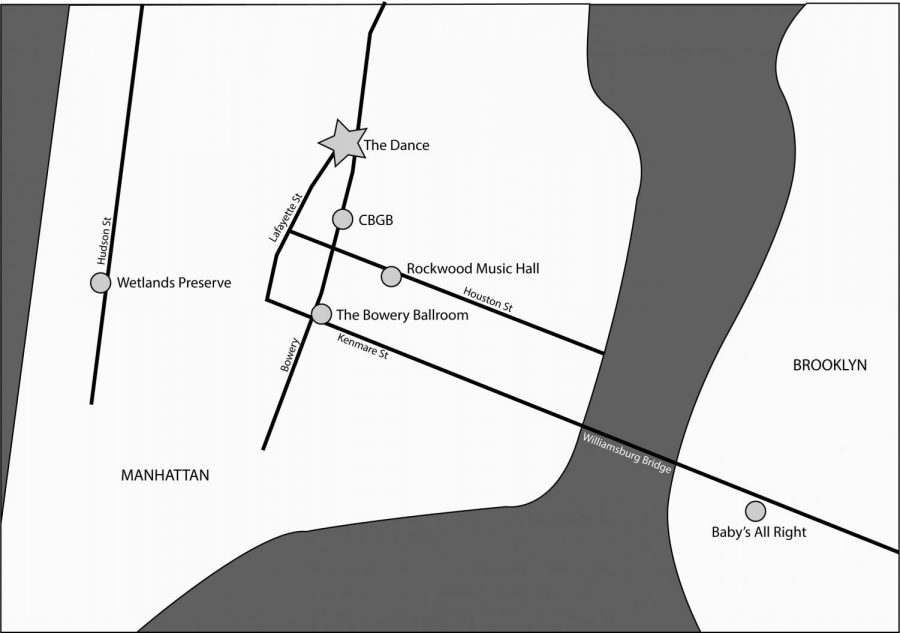‘Footloose’ in Manhattan: The Dance to Close
The Dance joins CBGB and Wetlands Preserve in the ranks of indie venues past, but the city’s DIY scene still thrives.
February 19, 2020
A young Lower East Side club and bar known as The Dance hosted its final performance on Feb. 18 after only four months of operation. On Feb. 10, management posted via Instagram that “the ownership group has respectively decided to pull the plug on this dream and go in another direction.” Fordham students will soon lose a beacon of live indie music in the city — and those who went will remember its performers for various reasons.
“I saw the lead singer try to hang upside down on the lighting rafters, but fall on his back onto a speaker,” said Liam Ryder, Fordham College at Lincoln Center (FCLC) ’21, about seeing Promiseland at The Dance.
Spacious and innovative, The Dance was constructed perfectly for a New York City venue. Small enough not to be a pain to fill, but not so small that it feels cramped, the venue’s layout suited its utility. Its 350-capacity stage room was enclosed by the club entrance area, including a vibrant but minimalist bar and dance floor. As guests entered, they would grab a drink and mingle as they make their way to the back, past the merch/ticket window, to the all-white corridor. The Dance made use of the little space it took up in a way that felt like more than just a bar with a stage.
The stage was elevated about 4 feet, the perfect height to dive into the crowd from, which is commonplace for both performers and patrons of the venue. The green room, located above the stage, was connected to it by a spiral staircase from which artists could elegantly descend into a sea of hollers. Behind the crowd and mosh was the club’s second bar, atop of which sat the front-of-house. The sound engineers had an unobstructed view of the stage, rather than being cramped in a corner somewhere or taking space from patrons.
“You can leave the show and be right around a bunch of places to eat and drink,” Alyana Vera, FCLC ’20, said. “The location was the best.”
Due to the scarcity of small, niche venues in Manhattan, concert-goers turn to Brooklyn to find intimate performances. Although Brooklyn is only a 30-minute train ride from Columbus Circle, finding local artists performing in Manhattan is an exercise in patience.
Billy Jones, co-owner, booker and promoter of Baby’s All Right in Brooklyn, started The Dance in the fall of 2019. This endeavor marked a grasp at the straws of NYC nightlife. Thousands of concerts are performed every month in Manhattan at venues like Bowery Ballroom or Rockwood Music Hall, but they seldom charge less than $25 and often showcase established artists on tour.
As a student, it isn’t always reasonable to frequent those shows and venues. It makes more sense, especially on a weekly basis, to seek out intimate performances further from the city, though The Dance provided a comparable option for a similar price.
Venues and event spaces like Trans-Pecos, Baby’s All Right and Gold Sounds are staples for that kind of intimate NYC music scene, which celebrates independent local artists. Venues like these have, for good reason, moved out to Brooklyn where they have more space and a younger audience. But because of this, Manhattan is missing an aspect of nightlife suited perfectly for the “broke college student” stereotype that The Dance provided.
On the subject of struggling venues in danger of being shut down, Vera said, “The Lower East Side is like that in general, which is a shame because most of those venues have a lot of history.”
Think of Hilly Kristal’s classic CBGB in NoHo or Pete Shapiro’s Wetlands Preserve in Tribeca. These were two of the most historic NYC venues. CBGB fostered the emergence of punk in America with bands like The Ramones, Blondie, The Misfits and Talking Heads. Wetlands was set up as an “eco-saloon,” meaning that the proceeds supported a not-for-profit Center for Social and Environmental Justice, which became a home for jambands and psychedelic rock aficionados. They each represent an era, and now that they’re gone, a part of the music industry ecosystem fades out.
The Dance didn’t reach that level of historical significance, but it did represent a possibly final attempt to keep the DIY music scene alive in NYC. The only lasting punk-ish venue in the area is Lola, which is mainly a bar filled with tables and booths that double as a venue with its tight corner stage. Compared to the rich, eclectic nightlife of the Lower East Side and the East Village, today’s scene is increasingly subpar.
Maybe this DIY exodus was inevitable. As NYC grows, smaller-scale productions will move out farther. Students will have to travel farther to enjoy affordable, live entertainment. But to what extent will we allow this? What if punks had to move to Long Island to enjoy a good mosh? What if the next generation of DIY is in Connecticut? That wouldn’t be worth the trek from campus.
Hopefully, we will have more Billy Joneses to support the local music scene of Manhattan. This will only be possible if we begin to appreciate the assets that venues like this are to students like us.














